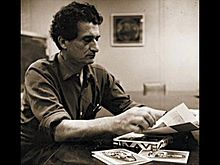Bedri Rahmi Eyüboğlu
Bedri Rahmi Eyüboğlu (* 1911 in Görele as Mehmet Bedri Rahmi , † September 21, 1975 in Istanbul ) was a Turkish painter and poet . He taught at the Mimar Sinan University of Fine Arts .
Life
Bedri Rahmi was born in 1911 as the second of five children of a civil servant. His older brother Sabahattin was a well-known writer and his sister Mualla was an architect, who became known as the restorer of the harem in Topkapı Palace .
Due to his father's work as provincial governor, Eyüboğlu lived in various cities in Turkey before he started school in Trabzon . In 1929 he moved to Istanbul to study at the Mimar Sinan Universitesi.
He briefly left the art school and studied in France in 1931, where his brother also lived. Rahmi learned French in Dijon and Lyon and then studied in Paris in Andre Lohte's studio , where he also met his future wife Ernestine Letoni (later often Eren ). The couple married in Istanbul in 1936.
After returning to Turkey he enrolled again and received his diploma in 1936. In 1937 he became Leopold Levy's assistant and translator . Eyüboğlu taught at the Mimar Sinan Universitesi until his death in 1975. He died of pancreatic cancer in 1975 and was buried in the Küçükyalı cemetery in Istanbul.
Work as a visual artist
Eyüboğlu held his first solo exhibition in 1935 in the Hasefer Gallery in the Romanian capital Bucharest . The exhibition was curated by his future wife Ernestine. Eyüboğlu soon received his first orders: he painted a fresco for the “Lido” restaurant in Istanbul (1943) and a large mural for the Ankara Opera House (1946). In 1938 he went to Edirne with the “Travel to the Country” organized for artists by the Republican People's Party ( Cumhuriyet Halk Partisi ) and in 1942 to Çorum and Iskilip to study Turkish folk art there. Here he developed a strong interest in the culture and imagery of the people of Anatolia and picked them up in his works.
From the mid-1950s, Eyüboğlu experimented with large-format abstract compositions with strong colors that took up stylized motifs from folk art or Ottoman art. For Expo 58 the artist created a 250 m² mosaic for the Turkish pavilion. In 1960 he created a mural for the NATO headquarters in Paris. After France left, NATO moved to Brussels and took the panel with them.
Eyüboğlu belonged to the Turkish avant-garde artist group "d Grubu" (Eng. "Group d") and was a co-founder of the "Group of Ten" for young painters, in which his students in particular organized themselves. Numerous mosaics can still be found on and in public buildings in Istanbul, most of which were created between 1937 and 1945. He also created a glass window for the Turkish embassy in Bonn. He also made a mosaic panel for the Palais de Chaillot in Paris.
On a trip to Paris he was impressed by the African art in the Musée de l'Homme . He decided to make greater use of wood panel printing and to create practical art such as textiles and glasses. He simplified his patterns and used ready-made boards that his students were also allowed to use. In 1960 he was invited to the United States with a Rockefeller Fellowship and a Ford Fellowship. He was also visiting professor at the University of California . The work "The Chain" is owned by MoMA today . In the United States he took influences from Abstract Expressionism and also from Tachism and Informel .
Work as a poet
Bedri Rahmi wrote for several literary magazines and the daily Cumhuriyet , where he wrote a weekly art column between 1952 and 1958. His first poems were published in 1941 under the title Yaradana mektup ( Letter to the Creator ). His second book Karadut ( Black Mulberry ) was published in 1948. He also wrote:
- Tuz , Osmanbey Mat., Istanbul 1952
- Üçü Birden , 1953
- Dördü Birden , 1956
- Karadut 69 , Bilgi Yayinevi, Ankara 1969
- Dol Karabakır Dol , 1974
- Yaşadım , 1977
- Tezek , 1987
literature
- Bedri Rahmi Eyüboğlu . In: General Artist Lexicon . The visual artists of all times and peoples (AKL). Volume 35, Saur, Munich a. a. 2002, ISBN 3-598-22775-2 , p. 563.
- Bedri Rahmi Eyüboğlu . In: Hans Vollmer (Hrsg.): General Lexicon of Fine Artists of the XX. Century. tape 2 : E-J . EA Seemann, Leipzig 1955, p. 64 .
- Ömer Faruk Şerifoğlu: Bedri Rahmi Eyüboğlu . (= Volume 3319, TC Kültür ve Turizm Bakanlığı Kütüphaneler ve Yayımlar Genel Müdürlüğü ), Turkish Ministry of Culture and Tourism, Ankara 2011
Web links
- Bedri Rahmi Eyüboğlu'nun şiirlerinde meyvelerin önemi ve kullanilişi , Çukurova Üniversitesi (Turkish)
- Website about Bedri Rahmi Eyüboğlu (Turkish)
Individual evidence
- ↑ a b c d Ateş Orga (Ed.): Istanbul: A Collection of the Poetry of Place . Eland, London, ISBN 978-0-9550105-9-0 , p. 48
- ↑ a b c d e Bedri Rahmi Eyüboğlu . In: General Artist Lexicon . The visual artists of all times and peoples (AKL). Volume 35, Saur, Munich a. a. 2002, ISBN 3-598-22775-2 , p. 563.
- ^ The Chain , MoMA, New York, accessed April 4, 2018
| personal data | |
|---|---|
| SURNAME | Eyüboğlu, Bedri Rahmi |
| ALTERNATIVE NAMES | Eyüpoğlu, Bedri Rahmi; Eyüboğlu, Bedrı Rahmı; Bedri Rahmi |
| BRIEF DESCRIPTION | Turkish artist and poet |
| DATE OF BIRTH | 1911 |
| PLACE OF BIRTH | Gorele |
| DATE OF DEATH | September 21, 1975 |
| Place of death | Istanbul |

